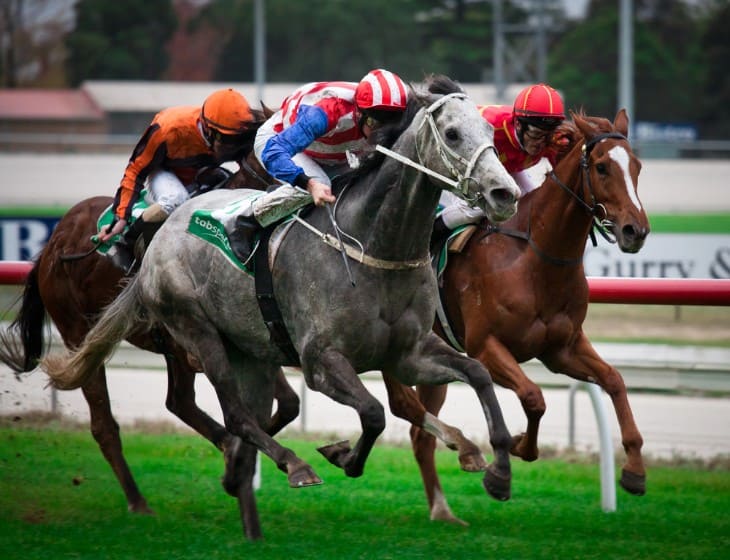- Racing Through Time: The Evolution of Horse Racing Rules and Regulations
- Global Gallop: The Expansion of Horse Racing Worldwide
- The Golden Age: Key Periods of Peak Popularity in Horse Racing
- Iconic Racecourses: A Journey Through Famous Venues
- Legendary Races and Racehorses: Profiles of Historical Significance
- The Role of Media and Technology in Popularising Horse Racing
- Horse Racing in Art and Literature
- Changing Dynamics: The Shift in Horse Racing Demographics and Sponsorship
- Conclusion
Racing Through Time: The Evolution of Horse Racing Rules and Regulations
As horse racing gained popularity, the need for standardised rules and regulations became increasingly evident. The 18th century marked a significant turning point in the formalisation of horse racing. The Jockey Club, formed in 1750 in England, played a crucial role in this evolution. It established comprehensive rules and standards that laid the groundwork for modern horse racing. The Jockey Club's regulations covered aspects such as weight allowances, race distances, and breeding guidelines, bringing a level of uniformity and fairness previously unseen in the sport.
Parallel to these developments in Britain, other nations began to cultivate their horse racing traditions, each adding unique elements to the sport. In the United States, for instance, the American Stud Book, established in the late 19th century, became instrumental in standardising breeding practices. This period also witnessed the emergence of iconic races such as the Kentucky Derby, which started in 1875 and soon became a cornerstone of American horse racing culture. Such international growth and the establishment of regulatory bodies worldwide signified the transition of horse racing from a pastime of the elite to a globally recognised and regulated sport.
Global Gallop: The Expansion of Horse Racing Worldwide
The global expansion of horse racing during the 19th and 20th centuries illustrates the sport's transition into an international phenomenon. This period witnessed the proliferation of horse racing across continents, with each region adapting the sport to its unique cultural context. In Europe, countries like France and Ireland developed strong racing traditions, with prestigious events such as the Prix de l'Arc de Triomphe and the Irish Derby gaining international acclaim. These races not only highlighted the sport's competitive aspect but also its cultural significance, often reflecting the societal values and histories of their respective nations.
In Asia and the Middle East, horse racing took on a different dimension. Countries like Japan and the United Arab Emirates embraced the sport, integrating it into their cultural and economic landscapes. The Japan Cup and the Dubai World Cup are prime examples of how these regions have not only adopted but also significantly contributed to the global horse racing scene. These events, known for their substantial prize money and international participation, have become fixtures in the global racing calendar, attracting the best talent from around the world.

The Golden Age: Key Periods of Peak Popularity in Horse Racing
Identifying the 'Golden Age' of horse racing involves examining periods when the sport enjoyed peak popularity. Several eras stand out for their significant impact on the sport:
- The Late 19th Century: This era saw the consolidation of horse racing as a major sport in countries like the United Kingdom and the United States. The establishment of classic races such as the Kentucky Derby and the Preakness Stakes during this period contributed greatly to the sport's popularity.
- The Interwar Period (1918–1939): Despite the challenges of the Great War, horse racing flourished in the interwar years. This period was marked by legendary horses like Phar Lap and Seabiscuit, whose stories captivated audiences worldwide.
- The Late 20th Century: A resurgence of interest in horse racing was seen in the latter part of the 20th century, partly driven by the advent of televised races. This era also witnessed increased commercialisation and globalisation of the sport.
These periods were characterised by several key factors:
- Cultural Impact: Horse racing became intertwined with national identities and cultural narratives.
- Technological Advancements: Improvements in broadcasting and betting technologies made the sport more accessible to a wider audience.
- Iconic Personalities: The emergence of legendary horses and jockeys contributed to the sport's allure and public appeal.
Each of these eras contributed uniquely to the tapestry of horse racing history, marking periods when the sport not only thrived in popularity but also evolved in its cultural and societal significance.
Iconic Racecourses: A Journey Through Famous Venues
The history of horse racing is inextricably linked to the iconic racecourses that have hosted its most memorable events. These venues, often steeped in tradition and history, are more than mere settings for the sport; they are institutions that have shaped the narrative of horse racing. In the United Kingdom, courses like Ascot, Epsom, and Aintree have become synonymous with the sport, each offering a unique racing experience. Ascot, home to the Royal Ascot meeting, is renowned for its association with the British royal family and epitomises the sport's elegance and prestige. Epsom Downs, the venue for the Epsom Derby, combines challenging terrain with a rich history, making it a true test of equine excellence.
Internationally, racecourses such as Churchill Downs in the United States and Flemington Racecourse in Australia are landmarks in their own right. Churchill Downs, host of the Kentucky Derby, is famed for its iconic twin spires and the exhilarating atmosphere of the Derby day. Flemington, home to the Melbourne Cup, Australia's most prestigious horse race, is known for its grandstand and the 'race that stops a nation'. These racecourses are not merely venues; they are cultural landmarks that have contributed to the local and national identity of the sport.
Legendary Races and Racehorses: Profiles of Historical Significance
The allure of horse racing is often encapsulated in the legendary races and racehorses that have left an indelible mark on the sport. These races and horses have not only defined eras but have also captured the public's imagination, elevating the sport's profile.
Key Races:
- The Epsom Derby: Established in 1780, it is one of the oldest and most prestigious flat races in the world, forming part of the British Triple Crown.
- The Kentucky Derby: Often referred to as "The Most Exciting Two Minutes in Sports," this race is a pinnacle of American horse racing.
Iconic Horses:
- Secretariat: The American thoroughbred racehorse known for winning the Triple Crown in 1973 and setting still-standing track records in two of the three events.
- Red Rum: A legendary steeplechaser from the United Kingdom, famous for winning the Grand National three times, a feat unmatched before or since.
These races and horses have contributed significantly to the sport's history:
- Cultural Resonance: Both the races and these horses have transcended the sport, becoming part of the wider cultural dialogue and capturing the attention of non-racing audiences.
- Historical Impact: Their stories and achievements have inspired future generations, shaping the perception and direction of horse racing globally.
The legacy of these races and horses is a testament to their extraordinary capabilities and the enduring appeal of horse racing as a sport. Their stories are woven into the fabric of the sport's history, immortalising their achievements and continuing to inspire fascination and admiration.
The Role of Media and Technology in Popularising Horse Racing
The advent of media and technology has played a pivotal role in popularising horse racing, transforming it from an elite pastime to a sport enjoyed by the masses. The early 20th century saw the emergence of radio broadcasts, which brought horse racing into homes, allowing people to follow races live. This development democratised access to the sport, expanding its fan base beyond those who could attend in person. The subsequent advent of television further revolutionised how horse racing was consumed. Major races were now broadcast globally, creating international excitement and anticipation. Iconic moments in horse racing history were captured on television, creating a shared experience for viewers worldwide.
The digital era ushered in a new phase of accessibility and engagement. The internet and online betting platforms have made it easier for fans to engage with the sport from anywhere in the world. Social media platforms and online streaming services have brought a new level of interaction, allowing fans to connect with jockeys, trainers, and fellow enthusiasts. These technological advancements have not only enhanced the viewing experience but have also facilitated a deeper understanding of the sport through analytics and data, making it more accessible to a new generation of fans.

Horse Racing in Art and Literature
Horse racing has exerted a profound influence on social and cultural spheres, particularly in art and literature. This influence reflects the sport's significance beyond the racecourse, capturing the imagination of artists and writers throughout history. In the realm of visual arts, horse racing has been a favoured subject, depicted in various styles and mediums. From the classical paintings of George Stubbs, renowned for his realistic portrayal of horses, to Edgar Degas' impressionist scenes of Parisian racecourses, the sport has inspired a diverse range of artistic expressions. These artworks not only celebrate the beauty and dynamism of horse racing but also provide insights into the social contexts of the times they were created in.
In literature, horse racing has been a recurring theme, featured in works ranging from classic to contemporary. Novels such as 'National Velvet' by Enid Bagnold and 'Seabiscuit: An American Legend' by Laura Hillenbrand have brought the excitement and drama of horse racing to a wider audience. These stories, often centring around themes of triumph, perseverance, and the human-animal bond, resonate with readers, further embedding horse racing into cultural consciousness. The portrayal of horse racing in literature often reflects broader societal issues and contributes to the sport's mythos, cementing its place in cultural history.
Changing Dynamics: The Shift in Horse Racing Demographics and Sponsorship
The demographics and sponsorship landscape of horse racing have undergone significant changes, reflecting broader societal shifts and the evolving nature of the sport.
Demographic Shifts:
- Audience Diversification: The audience for horse racing has become more diverse, with efforts to attract younger and more varied demographics. This shift is partly due to the sport's increased accessibility through media and technology.
- Participation Diversity: There has been an increase in the diversity of participants, including jockeys, trainers, and owners. Initiatives to encourage wider participation have contributed to this change, broadening the sport's appeal and perspective.
Sponsorship Evolution:
- Corporate Sponsorship: The role of corporate sponsors in horse racing has grown, with companies seeing the sport as a platform for reaching a broad and engaged audience. This has led to increased investment and commercialisation of the sport.
- Innovative Partnerships: Partnerships with non-traditional sponsors, including those from technology and entertainment sectors, have introduced new dynamics into the sport, influencing its marketing and engagement strategies.
These shifts have implications for the future of horse racing:
- Broader Appeal: The diversification of audiences and participants is likely to broaden the sport's appeal, making it more inclusive and reflective of wider society.
- Commercial Opportunities: The evolution in sponsorship presents new commercial opportunities, potentially leading to innovative ways of engaging with audiences and enhancing the sport's profile.
The changing demographics and sponsorship landscape of horse racing indicate a sport in transition, adapting to new challenges and opportunities while striving to maintain its rich heritage and appeal.
Conclusion
In conclusion, the history of horse racing is a narrative of evolution and adaptation. From its origins in ancient civilisations to its current status as a global sport, horse racing has left an indelible mark on culture, society, and economies. The sport has evolved over centuries, influenced by technological advancements, changing social dynamics, and the shifting landscapes of media and sponsorship. The iconic racecourses, legendary horses, and memorable races all contribute to the rich tapestry of horse racing history.
For more information:







